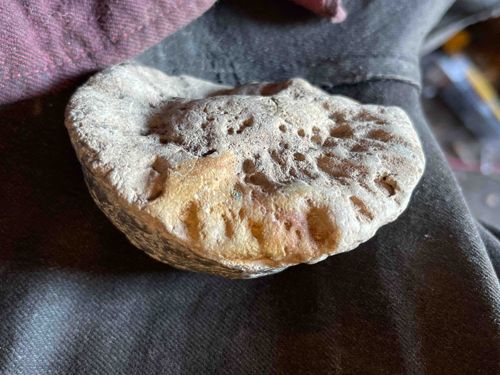
Weathered Stone Concretion / Geode Fragment
The item appears to be a natural geological formation, likely a concretion or a geode fragment, rather than a fossilized egg. Its overall shape is somewhat irregular and ovoid, but distinctly flattened, roughly measuring in the range of 4-6 inches in its longest dimension. The material is a light grayish-beige stone, exhibiting a porous and highly textured surface on its upper visible side, characterized by numerous small, irregular indentations and pits, some appearing to be natural voids or weathered areas. There are no consistent structural patterns or cellular structures indicative of an organic origin like an eggshell. The underside or edge visible on the right reveals a smoother, more solid texture with a brownish-yellow hue, suggesting a different mineral composition or weathering pattern on that surface. There are also hints of reddish-brown discoloration in some of the recesses on the yellowish portion, possibly due to mineral staining or oxidation. The construction is natural, showing no signs of human modification, carving, or repair. Its condition appears stable, with the observed porosity and irregularities being inherent features rather than damage. There are no discernible maker's marks, signatures, or specific manufacturing details, as it is a natural object. Without further geological analysis, a precise age is difficult to determine, but such concretions can form over long geological periods. The craftsmanship is naturally occurring, reflecting geological processes rather than human artistry. The unique aspect is its intriguing, somewhat egg-like shape combined with its heavily pitted and irregular surface texture.
AI-Generated Appraisal Disclaimer
Estimated Value
$40-$75
Basic Information
Category
Geological Specimen / Fossil
Appraised On
December 1, 2025
Estimated Value
$40-$75
Additional Details Provided By Owner
User Provided Information
Fossilized egg?
Item Description
The item appears to be a natural geological formation, likely a concretion or a geode fragment, rather than a fossilized egg. Its overall shape is somewhat irregular and ovoid, but distinctly flattened, roughly measuring in the range of 4-6 inches in its longest dimension. The material is a light grayish-beige stone, exhibiting a porous and highly textured surface on its upper visible side, characterized by numerous small, irregular indentations and pits, some appearing to be natural voids or weathered areas. There are no consistent structural patterns or cellular structures indicative of an organic origin like an eggshell. The underside or edge visible on the right reveals a smoother, more solid texture with a brownish-yellow hue, suggesting a different mineral composition or weathering pattern on that surface. There are also hints of reddish-brown discoloration in some of the recesses on the yellowish portion, possibly due to mineral staining or oxidation. The construction is natural, showing no signs of human modification, carving, or repair. Its condition appears stable, with the observed porosity and irregularities being inherent features rather than damage. There are no discernible maker's marks, signatures, or specific manufacturing details, as it is a natural object. Without further geological analysis, a precise age is difficult to determine, but such concretions can form over long geological periods. The craftsmanship is naturally occurring, reflecting geological processes rather than human artistry. The unique aspect is its intriguing, somewhat egg-like shape combined with its heavily pitted and irregular surface texture.
Related Tags
Get Your Items Appraised
Instant estimates of your treasures with AI-powered instant appraisals